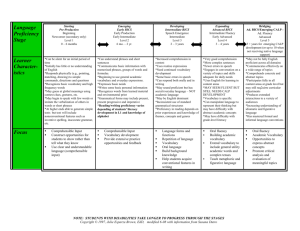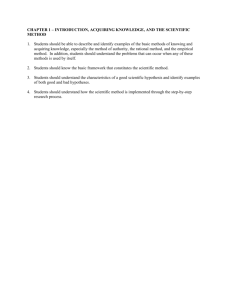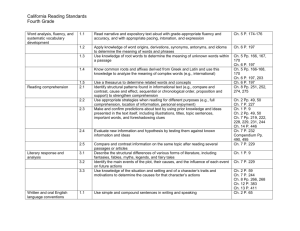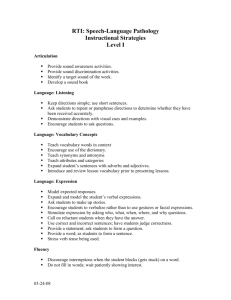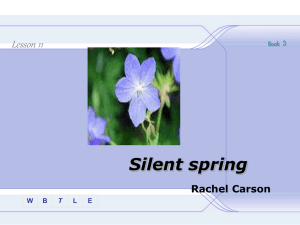Working with English Language Learners:
advertisement
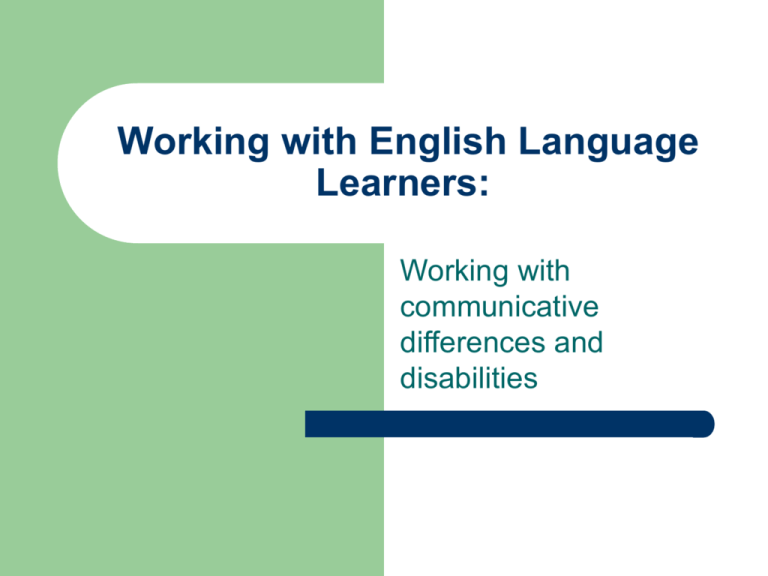
Working with English Language Learners: Working with communicative differences and disabilities Cultural Differences The rules of conversation are different among the world’s cultures There are many factors that influence how a person communicates with others: Age Relationship Situation Expected Outcome Oral Tradition Previous Education Gender Specific Responses Cultural and Linguistic Differences Language System variables such as soundsymbol relationships and methods of communication are important factors Culture Shock of students must be taken into consideration when evaluating students Acculturation process must be reviewed and accepted Acculturation Process Euphoria Culture Shock Integration Acceptance Language Acquisition vs. Language Learning Language Acquisition is the process by which children acquire language (subconscious and natural) much like learning their first language Language Learning is not communicative. It is the result of direct instruction and is most likely not appropriate for very young learners Stages of Language Acquisition Silent Period/Pre-production Stage Early Production Stage Speech Emergence Stage Intermediate Language Fluency Stage Silent Period/Pre-production Duration is 10 hours up to six months Students often have about 500 “receptive” Students may not make any utterances, but can do some classroom activities through pointing, drawing and acting Students should not be forced to speak! Early Production Can last an additional six months after the Pre-production Stage (6+6=12) Students have developed close to 1,000 receptive/active words Students can usually speak in one or two word phrases Yes/no, either/or, who/what/where/when questions and answers Speech Emergence Stage Can last up to another year (6+6+12=24) Students have developed about 3,000 words and can use short phrases and simple sentences to communicate Students begin to use simple dialogue Students may produce longer sentences, but frequently with numerous grammatical errors and pronunciation differences Intermediate Language Fluency May take up to another year after the Speech Emergence Stage (6+6+12+12=36) Students have typically developed about 6,000 words and can make more complex sentences and questions as well as speak at greater length Advanced Language Proficiency Five to seven year process Accent often remains Students have learned how to communicate well in social situations and can usually handle themselves without help Students have learned many specialized vocabulary words BICS vs. CALP Basic Interpersonal Communication Skills or BICS are conversational language skills that usually develop within two to five years Cognitive Academic Language Proficiency or CALP is the ability to understand academic (education) language and can take from seven to ten years to completely develop So…How Long Does It Take??? Research has been done in a variety of settings and with different language groups. It looks something like this: Students who were between 8-11 years old and had 2-3 years of native language education took 5-7 years to test at grade level Students with little or no formal schooling who arrived before the age of eight, took 7-10 years to reach grade level norms in English language literacy Students who were below grade level in native language literacy also took 7-10 years to reach the 50th percentile. Most never reached grade level norms Acquiring a Second Language…What’s “Normal,” What’s Not Interference: – ESL children may manifest interference or transfer from their first language to English. This means that a child may make an English error due to the direct influence of a native language structure. For example, in Spanish, “esta casa es mas grande” means “this house is bigger.” However, a literal translation would be “this house is more bigger.” A Spanish-speaking child who said, “this house is mor ebigger” would be manifesting transfer from Spanish to English. This is a normal phenomenon-a sign of a language difference, not a language disorder. Acquiring A Second Language… Silent Period: – The younger the child, the longer the silent period tends to last. Older children may remain in the silent period for a few weeks or many months, whereas preschoolers may be relatively silent for a year or more Acquiring a Second Language… Code switching: – This involves changing languages over phrases and sentences. For example, a Spanish speaker might say- “Me gustaria manejar-I’ll take the car!” (“I’d like to drive-I’ll take the car”). Or, a Filipino student might say, “With my teacher, I have utang ng loob (debt of gratitude) because she has been so good to me.” Again, this is a normal phenomena engaged in by many fluent bilingual speakers worldwide. Acquiring a Second Language… Language Loss: – Some children who are English language learners undergo the phenomenon of language loss. As they learn English, they lose skills and fluency in their native language if their native language is not reinforced and maintained. How Should Students Learn? The idea of “the more English the better” has proven to be fallacious and can actually slow down a student’s learning considerably Research shows that the average native speaker gains about 10 months of a academic growth in a school year. The ELL must outgain the native speaker by making 1.5 years’ progress in English for six successive school years. In order to have skills that are commensurate with those of native English speakers, ELLs must make nine years progress in six years. So…can somebody help me with this process of getting the testing done? Please contact the ESL Department for assistance with questions 412.622.3736 Translators can be made available as needed for evaluation and/or IEP meetings. Always…always…always…find out how long the student has been here before you begin to test You can do it… Remember that doing an evaluation on an ELL can be complicated, but can be done. If you have any questions whatsoever, please don’t hesitate to call us!
